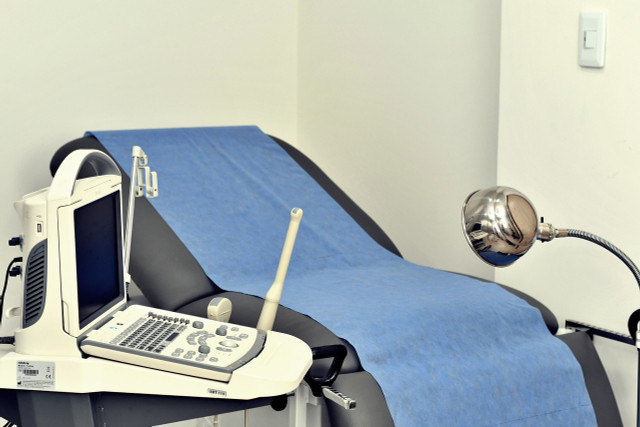
In adenomyosis, abnormal tissue grows in the muscular layer of the uterus. The disease often goes undiagnosed because its symptoms are similar to those of endometriosis. You can find out more here.
Adenomyosis uteri, or adenomyosis for short, is a condition in which tissue that normally lines the inner layer of the uterus (endometrium) invades the muscular layer of the uterus (myometrium). This leads to pain and other symptoms.
Adenomyosis uteri was previously often considered a subtype of endometriosis and referred to as “interna genital endometriosis”. The reason is that adenomyosis appears to be responsible for many of the clinical symptoms that were previously attributed to endometriosis, according to Springer Medicine.
However, it is now known that these are two independent diseases, which is why this term is no longer used. But important to know: According to the Dernbach Hospital, around 50 percent of all patients with adenomyosis also have endometriosis.
Adenomyosis: These are the symptoms

(Photo: CC0 / Pixabay / pikulkeaw_333)
Endometriosis has received increased attention recently. Things are different with adenomyosis, although it is also a disease that affects the tissue of the uterus. Adenomyosis refers to the presence of uterine lining in the area of the uterine wall (uterine muscle). According to the Dernbach Hospital, those affected by this disease suffer from the following symptoms:
- chronic abdominal pain
- particularly heavy menstrual bleeding with severe pain
- Pain during and after sexual intercourse
- painful bowel movements, including diarrhea, bloating, cramps and painful bowel movements
- Painful urination and frequent occurrence of symptoms similar to a bladder infection
- Back pain that often radiates to the buttocks and thighs
- Tiredness, exhaustion and depressive moods
- Infertility (as the abnormal tissue in the uterus makes it difficult for the egg to implant, explains the fertility doctor)
- Nerve pain in the lower body and leg areas
The symptoms are therefore very similar to those of endometriosis.
Difference between Adenomyosis and Endometriosis
The main difference between endometriosis and adenomyosis is where the abnormal endometrial tissue is located.
- In endometriosis, it grows outside the uterus, for example in areas such as the ovaries, fallopian tubes, peritoneum, and other abdominal organs.
- In adenomyosis, however, it occurs within the uterine wall, in the muscle tissue. Both diseases can cause severe pain and other symptoms by causing bleeding and inflammation.
Diagnosis of adenomyosis

(Photo: CC0 / Pixabay / orzalaga)
According to the Endometriosis Association of Germany, between five and 70 percent of all people with a uterus of “childbearing age” are affected. The limited knowledge about the frequency of adenomyosis results in part from the fact that in the past, doctors often diagnosed the disease only incidentally, after the uterus was removed for other medical reasons, rather than specifically based on symptoms or examinations. Even today, adenomyosis is most often diagnosed in people who are actually being examined for endometriosis, fibroids or pelvic pain, according to the MSD Manual.
The diagnosis is then made by specialized doctors who recognize certain features in vaginal ultrasound or magnetic resonance imaging (MRI). They can determine whether a person is likely to have adenomyosis. Typical signs are
- an enlarged uterus,
- unusual shapes of the uterine wall and
- a widened junctional zone (layer between the uterine lining and the muscle layer).
If endometriosis is suspected, a tissue sample is often taken during a laparoscopy to confirm the diagnosis. In the case of adenomyosis, however, the diagnosis is not always clear based on tissue samples alone.
Treatment of adenomyosis
There are various options for treating adenomyosis, both medical and surgical. According to the Endometriosis Association Germany these are the following:
-
Hormonal and non-hormonal drugs: To date, there is no preferred hormonal drug for the treatment of adenomyosis. Options include GnRH analogues that induce artificial menopause, the hormonal IUD, pills with progestin or estrogen and progestin.
-
Surgical methods: Depending on whether the adenomyosis foci are diffusely scattered or concentrated in certain points, their surgical removal is better or worse. The uterus can be preserved.
-
Hysterectomy: Once family planning has been completed and a detailed consultation has taken place, a hysterectomy can also be considered.
-
Radiological forms of therapy: There are, for example, methods that use high-frequency, focused ultrasound to remove the lesions. However, their effectiveness has not yet been sufficiently proven and should only be used in clinical studies.
-
Complementary treatments: Herbal remedies for cycle regulation, multimodal pain therapy, sport, physiotherapy and psychological support can improve the quality of life of those affected.
Read more on Techzle\.com:
- Menstrual cramps: These home remedies help
- Home remedies for stomach pain: What really helps
- Red clover: effect and use as a remedy